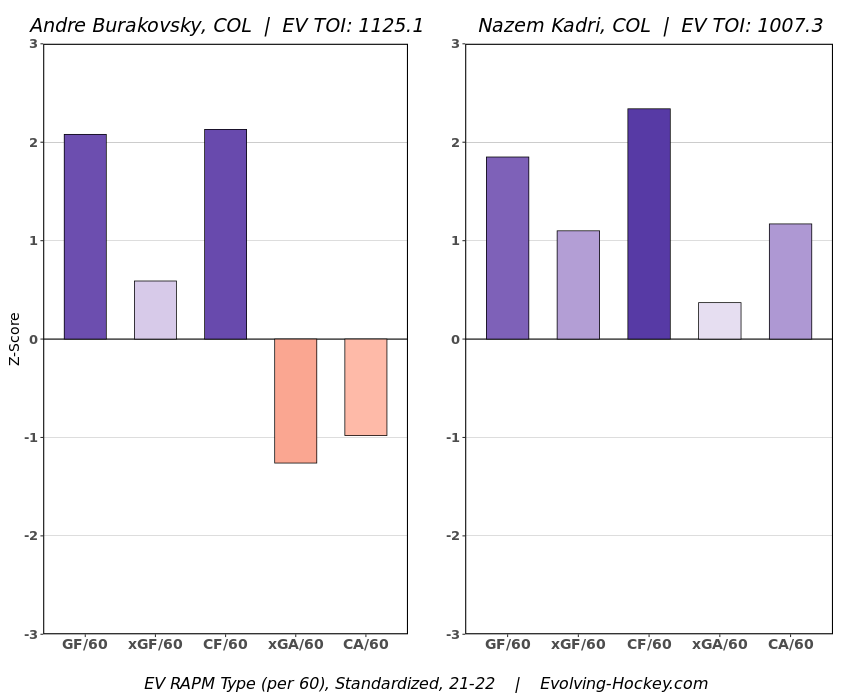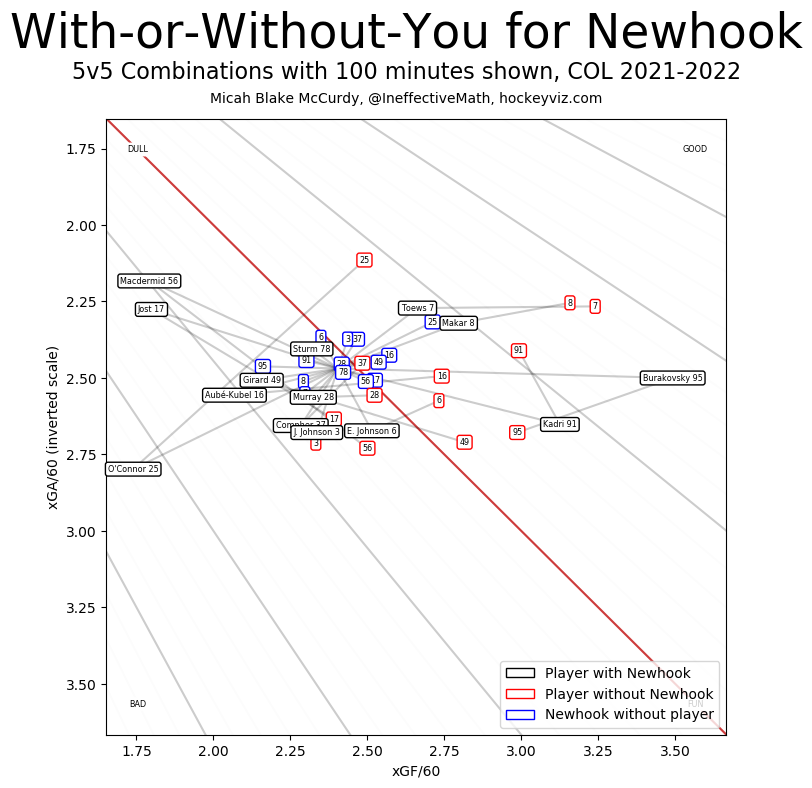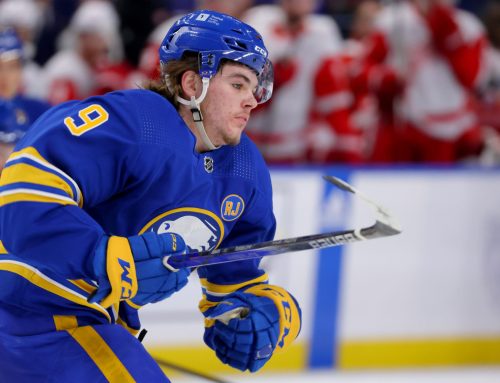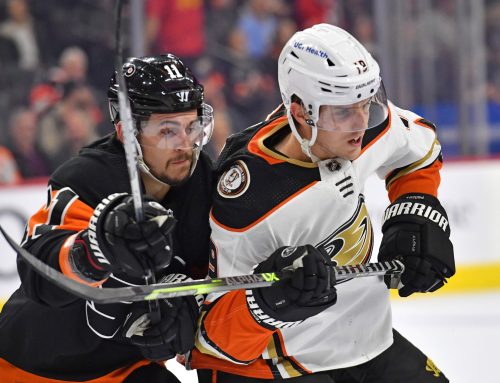The 2022 NHL Entry Draft is just around the corner – a week away – meaning there is no time like the present to get caught up on all the prospects fantasy owners need to know. Head on over to the Dobber Shop to grab your copy of the 2022 Dobber Fantasy Hockey Prospects Report. In conjunction with our great Dobber Prospects team, the Boss and the DP crew put together over 500 prospect profiles. There are estimated NHL arrival times, fantasy upside, depth charts, and a whole lot more. Help support the entire Dobber crew and get up to speed on the young guns that fantasy owners need to know!
After a few of first- and second-round exits with the current core, the Colorado Avalanche ran roughshod over the postseason, going 16-4 and lifting the franchise's first Stanley Cup in over 20 years. It was a dominant nine-month performance from the Avs, who finished second in the regular season in points percentage (behind Florida).
It is time to look ahead to the fantasy 2022-23 season and we're going to finish off our season's recaps today. In my Ramblings, I have been reviewing the season of each playoff team following elimination and Colorado will cap this off. We are going to look at the season's performance from some of their key players, the work the management team has to do in the offseason, what this team could look like for next season, and what it means in the fantasy game.
As usual, our data will largely come from Natural Stat Trick and our own Frozen Tools. There will be some player tracking data used from Corey Sznajder's Patreon (he hand-tracks games to break player contributions down further). Other sources will be credited as they're used.
Valeri Nichushkin, Nazem Kadri, and Andre Burakovsky
The biggest storyline for Colorado in the offseason is how to keep as many of their supporting cast as they can. Calling Kadri and Nichushkin, especially, a supporting cast is a disservice, but I mean it in the differentiation between guys brought in, and guys drafted and signed long-term by the team.
Nichushkin has finally reached his upside, not only in two-way play but also production. It took a long time, but he had 25 goals and 52 points in 62 games during the regular season, adding 15 points in 20 games in the postseason. What is more impressive about his regular season production is he had just nine points with the man advantage, or about 17% of his production. For reference, Nathan MacKinnon had three times as many PPPs as Nichushkin did. With a regular top PP role, he could have been a point-per-game player, to go along with excellent 5-on-5 defence. Truly just an absolute monster for the Avalanche.
That point-per-game production came for Kadri, who was a fixture of the top PP unit for much of the season. He posted a massive 87-point total in just 71 games, and that mark of 1.23 points per game was nearly a half-point higher than his next-best 82-game season (0.74 in 2016-17). By the scoring chance data I've referenced in several recent Ramblings (scoring chances taken + created for teammates per minute), Kadri was top-25 in the league, ahead of names like Leon Draisaitl, Patrick Kane, and teammate Mikko Rantanen. The team scored 3.7 goals per 60 minutes at 5-on-5 with him on the ice, slightly lower than his 2019-20 season in Colorado, on the back of 9.7% team shooting with him on the ice. That part is key: this wasn't a huge percentage binge for him or the team. Across the league, that 9.7% team shooting put Kadri near the 70th percentile, which does not scream regression.
Because Burakovsky didn't have a great postseason (partially due to injury), we could be forgiven for forgetting that he had a career-best 22 goals and 39 assists in the regular season. He cracked 60 points for the first time, having never even cracked 50 points before. He didn't have the huge play-driving seasons that Kadri and Nichushkin did, but he was still solid in this regard (from Evolving Hockey):

He was good, not great, but a championship team doesn't need to be great top to bottom. Having good players to help the stars is essential, and Burakovsky was exactly that.
The crux, obviously, is that all three are unrestricted free agents. According to contract projections from the aforementioned Evolving Hockey, we could see Nichushkin around $6M a season long-term, Kadri closer to $8M, and Burakovsky also around $6M on a shorter 3- or 4-year deal. They could theoretically sign them all with their $25M+ in cap space, according to Cap Friendly. If they did that, they would probably have to trade Artturi Lehkonen (a restricted free agent) and go league-min salaries for their fourth line and backup goalie (assuming Darcy Kuemper leaves the franchise in free agency himself). There is the added issue of both Nathan MacKinnon and Bowen Byram needing new contracts after next season. The team only has so much money to go around, so there will be difficult decisions to be made.
My read on this is that unless he takes a discount, Kadri probably tests free agency. We can scoff at the $8M AAV projection, but Matt Duchene got that from Nashville back in 2019, even if he was younger and before the pandemic cap issues. Even $7M a season could be a lot to give a 32-year-old centre on a long-term deal. That would leave Colorado thin at centre after MacKinnon, likely relying on either J.T. Compher or Alex Newhook to pick up the slack. An out-of-the-box idea I've had is that they move Rantanen to 2C, as they did a lot in 2021-22, as the Kadri 'replacement'. It would leave Compher in a more comfortable 3C role and let Newhook move all over the roster as needed.
When Lehkonen was acquired at the trade deadline, my thought was that he'd be the Nichushkin replacement. (For more on Lehkonen, I wrote about his season a few weeks ago, and how he compares to the Russian winger.) But really, they have the room to sign both if they want, assuming Kadri and Kuemper sign with other teams. They would still have lots of cap space in 2023 for MacKinnon and Byram on long-term deals, with enough left over to fill out the roster. Given Nichushkin's important role to the team – he was second behind MacKinnon in 5-on-5 TOI during the postseason – and the fact he's only going into his age-27 season, a 6- or 7-year deal at a $6M AAV seems just fine.
If there's one issue that Colorado might run into, it's that the prospect cupboard is bare. Newhook and Byram were the team's top skater prospects, and both have graduated to the big club. They don't have a Mason McTavish or Jack Quinn looking like a superstar in lower leagues that could step in and be a significant contributor in 2022-23. In that sense, if this team really wants to keep piling up championships, Newhook needs to take his next step.
To be fair to Newhook, he looks like an NHLer. What kind of NHLer remains to be seen, but it seems obvious he's not someone that should struggle to stay in the lineup moving forward. With that said, there is a big difference between being a third-line tweener, and being a top-6 contributor. If they lose both Kadri and Burakovsky, they need him to step up for the team. So how did his season go?
The scoring chance data referenced earlier looked good for Newhook. The Newfoundlander wasn't game-breaking, but he was in the middle of the league in our sample (108th out of 215 forwards with at least 250 minutes tracked). His rate of scoring chances taken+created of 7.15/60 minutes was slightly ahead of Nichushkin, and ahead of wingers like Tomas Tatar and Teuvo Teravainen. The problem is it didn't translate to much in expected goals, as evidenced by the following chart from Hockey Viz. The red numbers to the right of the blue numbers show players generating more expected goals away from him, or at the least being neutral:

For comparison's sake, Trevor Zegras in Anaheim basically has the inverse, where almost every player was worse off offensively without him than with.
This is where I wonder if some of this isn't misleading because of the team he's on. For example, when he was not playing with Kadri, it's a good bet someone like Nichushkin, Landeskog, or Burakovsky was. Asking Newhook to out-perform those guys, as a rookie, is asking a lot. The bottom-6 wasn't particularly great, either. He played nearly half his 5-on-5 time with either Compher or Nico Sturm (or both) and those guys have a career points-per-game mark of 31 points/82 games combined. Unsurprisingly, then, his expected goals for per 60 minutes went up 31% when playing with Kadri, and they were a 52% expected goal share line.
I don't think it's a coincidence the team's entire top-6 were their top-6 players in points per 60 minutes at 5-on-5. It was one of the most dominant top-6 groups in recent memory, but it didn't leave a lot for Newhook to play with. Despite some muted stats, he had good controlled zone entry rates, good shooting rates, and good scoring chance contribution rates. Those are some of the underlying stats we look to for guys that can create offence.
His problem, for fantasy, is his role. Unless he's in that vaunted top-6, asking for more than a 50-point season is asking a lot. It's unlikely that the bottom-6 is much deeper than it was this season, so he'll really have to start showing out offensively to be useful in most fantasy leagues. If they do decide to use him in the top-6, though, he could start showing some of that offensive creativity with players who can reciprocate that creativity, and he could start showing his upside. It's a lot of ifs to work through, though. They could just as easily use Compher in the top-6 and leave Newhook on the third line.
It had been a very rough start to Byram's NHL career. He suffered at least one (if not two) concussions during his rookie season back in the COVID 2021 campaign. That left him unable to play most of the season and the playoffs. He had a great start to the 2021-22 campaign with 8 points in 10 games but then suffered another concussion that took him out of the lineup again. He tried to return but the symptoms persisted into January, and he was back on the injured list thanks to his second (or third) concussion in 12 months. He returned in April of this year but had a lesser role, skating under 18 minutes a game (but still had 6 points in 12 games). For comparison's sake, his first 10 games of 2021-22 saw him skating over 21 minutes a game.
This postseason, though, was a different story.
Byram started the first round against Nashville skating the low minutes he finished the season with, something that persisted into the St. Louis series. Through the first two rounds, he skated 16:29 a night, never cracking the 20-minute mark. That changed in a big way in the Western Final as he cracked the 20-minute mark in Games 1 and 2 and ended up skating 22:14 a night over the final two rounds. He nearly added six full minutes of TOI per game over his final 10 postseason appearances compared to his first 10. Believe it or not, over those final 10 games, he skated more at 5-on-5 per game than Cale Makar.
It was for good reason, too. It wasn't as if Byram was a guy they leaned on because they had no other choice; he legitimately played very well for them. The evidence is from the Patreon mentioned earlier, which tracks many things that happen on the ice. According to GameScore (which factors in shots, zone entries/exits, playmaking, etc.), on a per-60 basis, Byram was one of the most effective defencemen in the postseason (along with a few other Colorado blue liners):

Even if it's just a 20-game sample with half the league missing, seeing Byram do so well in a variety of tracked stats is encouraging.
Leaving aside the concussion problems, Byram's biggest issue is his role. Barring injury, he's not taking the PP1 role from Makar, and he may not take a PP2 role from Devon Toews or Sam Girard. Even if he does get some PP2 time, he could very well be fourth in overall TOI. With Makar, Toews, and Girard around, the blue line is loaded, and as good as Byram is, with his injury history, maybe they don't give him 22 minutes a night with secondary PP time. He could be around 19-20 with sparse PP time. From a fantasy perspective, expecting more than 40 points out of him is expecting too much, even on a great offensive team like this. There are only so many defence points to go around for guys that will have secondary/non-existent power-play time.
For dynasty owners, though, this has to have been a very eye-opening postseason. With Girard injured, Byram stepped up in a big way for the Avs and showed he should be a great second-pairing guy immediately (if only because the top pair is stacked). Toews only has two years left on his deal and Byram could easily play himself past Girard on the depth chart. But that's a couple years down the road, and for now, I think he'll have more real-world value than he will fantasy value.
All told, losing Kadri will hurt, but being able to use Rantanen as a 2C could paper a lot of issues, especially with Nichushkin and Lehkonen returning on the wings. Makar looks every bit a generational defenceman, and the triumvirate of Toews/Girard/Byram to go with him makes it an elite puck-moving unit. Colorado should be an offensive juggernaut again in 2022-23, if a little top-heavy up front.





 EDM
EDM PIT
PIT TOR
TOR FLA
FLA VAN
VAN MIN
MIN DET
DET COL
COL NSH
NSH
